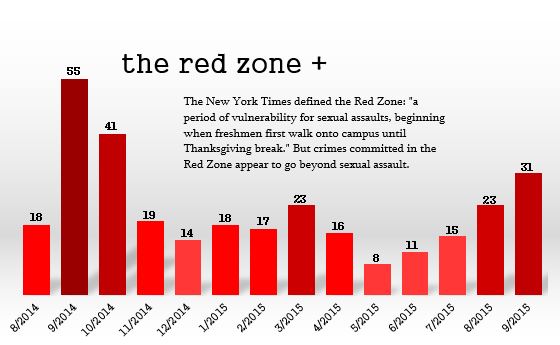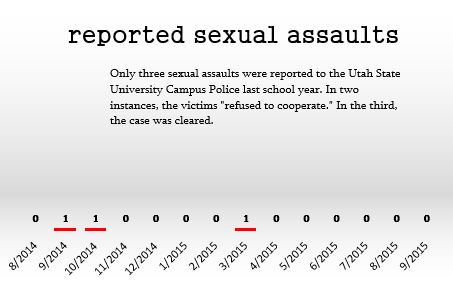Officials discuss growing concern of campus crime
Campus officials at Utah State University are reporting a steady increase of crime every year — especially sexual assault, and particularly at the beginning of the school year.
The average number of crimes committed per month on campus is 22. During the first few months of the school year, the average jumps to 38. Campus Police Chief Steve Mecham said it takes a while for students to learn they need to take precautions.
“The university is generally a safe community, but there’s still crime that happens,” he said. “So I think that maybe the students don’t stop to think about that, and so they’re a little bit careless about where they lay their property, or they leave their apartments open.”
According to the university’s Annual Campus Security and Fire Safety Report, students are at highest risk of sexual assault from early August through Thanksgiving break. This period is called the Red Zone.
Sexual Assault and Anti-Violence Information, or SAAVI, coordinator Jenny Erazo has been with the university for three years. At the beginning of the school year, Erazo hires five interns to help sexual assault victims.
“Since I’ve been here, each year the number of students that have come in has increased over the first of the semester,” she said. “I was talking to a county attorney, and she was noting an increase in cases.”
Victims have several avenues for reporting sexual assaults on campus, including through SAAVI, the Department of Student Services or the Counseling Center.
“We know that there are more that occur that are not reported,” Mecham said. “They don’t have to report it to the police. Our concern is that victims of sexual assault get the help that they need — help them get through it.”
Sexual assaults account for less than one percent of crimes reported to the campus police. Only three incidents were reported to the USU Campus Police last school year. In two instances, the victims “refused to cooperate.” In the third, the case was cleared.
“That means that we investigated it, we know he did it, we know it happened — but we’re not going to prosecute,” Mecham said.
Although the term “Red Zone” only embodies sexual assaults, all campus crimes spike at the beginning of the school year, particularly liquor law violations and theft. Combined, they account for 44 percent of campus crime throughout the year.. Criminal mischief and ordinance violations follow at 9 percent each. Controlled substance violations are next at 6 percent.
“We take very low tolerance to alcohol violations, and so if we have an alcohol violation, it almost always ends up in an arrest or a citation,” Mecham said. “And so that gets the knowledge out there that, ‘Hey, if I get caught, it’s gonna cost me a lot of money.’”
Representatives for campus police meet with resident assistants, housing directors and students enrolled in the Connections course to talk about the beginning-of-the-year potential of becoming the victim of a crime. Mecham added that he strives to have more officers on duty during the first few weeks of school.
Executive director for Housing and Residence Life Steven Jenson said he and his staff want students to be aware of potential dangers. Additionally, he has taken measures to make on-campus housing more secure.
“Recently — a year ago — we started locking all the external doors 24/7 so that only people that are supposed to be in the buildings can access it,” he said.
Jenson sits on the Behavior Intervention Team, or BIT. Organized by student services, BIT is a team of professionals designed to assess, refer and interview students of concern. The Residence Hall Association takes safety very seriously, Jenson said.
Mecham, Jenson and Erazo agreed they want students to be aware of the dangers on campus, and the first few months of the school year are a time to be cautious and educated.
“We get a bunch of students who are away from home for the first time, and so they’re spreading their wings — sowing their wild oats, so to speak,” Mecham said.
— brennakelly818@gmail.com


